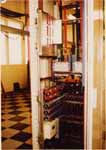IrDA is a standard from the 'Infrared Data Association'
Physical Layer
For the bit transmission layer IRDA published two standards: SIR(Serial IR Physical Layer) and FIR(Fast IR Physical Layer).
IrDA is a halfduplex protocol, that is, only one direction transmits at a time. I guess this is because, otherwise if receiver and transmitter ware operating simultaneously, the light beam being sent may swamp the incoming detector.
Serial IR - SIR
This uses the serial interface implemented the common serial interface of a PC(UART 16550). Data transfer rates in this mode are limited to 115200bps.
Fast IR - FIR
FIR provides data transfer rates from 1.15Mbps to 4Mbps. Data transmission with 4 Mbps uses Pulse Position Modulation (PPM) with four possible positions per data symbol.
Data Transfer layer
This is based on SDLC, which is a polling protocol which works well with the halfduplex physical layer. This is because the controller end of the link sends out commands and the other end only responds only when commanded.
Example
This page shows how to setup a IrDA link on a Linux system.
